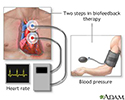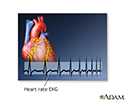Biofeedback
Biofeedback is a technique that measures bodily functions and gives you information about them in order to help train you to control them.
Biofeedback is most often based on measurements of:
- Blood pressure
- Brain waves (EEG)
- Breathing
- Heart rate
- Muscle tension
- Skin conductivity of electricity
- Skin temperature
By watching these measurements, you can learn how to change these functions by relaxing or by holding pleasant images in your mind.
Patches, called electrodes, are placed on different parts of your body. They measure your heart rate, blood pressure, or other bodily function. A monitor displays the results. A tone or other sound may be used to let you know when you have reached a goal or certain state.
Your health care provider will describe a situation and guide you through relaxation techniques. The monitor lets you see how your heart rate and blood pressure change in response to being stressed or remaining relaxed.
Biofeedback teaches you how to control and change these bodily functions. By doing so, you feel more relaxed or more able to cause specific muscle relaxation processes. This may help treat conditions such as:
- Anxiety and insomnia
- Constipation
- Tension and migraine headaches
- Urinary incontinence
- Pain disorders such as headache or fibromyalgia
- Alcoholism and other substance use disorders
References
Hecht FM. Complementary and integrative medicine. In: Goldman L, Cooney KA, eds. Goldman-Cecil Medicine. 27th ed. Philadelphia, PA: Elsevier; 2024:chap 30.
Hosey M, McWhorter JW, Wegener ST. Psychologic interventions for chronic pain. In: Benzon HT, Raja SN, Liu SS, Fishman SM, Cohen SP, eds. Essentials of Pain Medicine. 4th ed. Philadelphia, PA: Elsevier; 2018:chap 59.
White JD. Complementary and alternative medicine. In: Niederhuber JE, Armitage JO, Kastan MB, Doroshow JH, Tepper JE, eds. Abeloff's Clinical Oncology. 6th ed. Philadelphia, PA: Elsevier; 2020:chap 31.
Review Date: 12/31/2023










